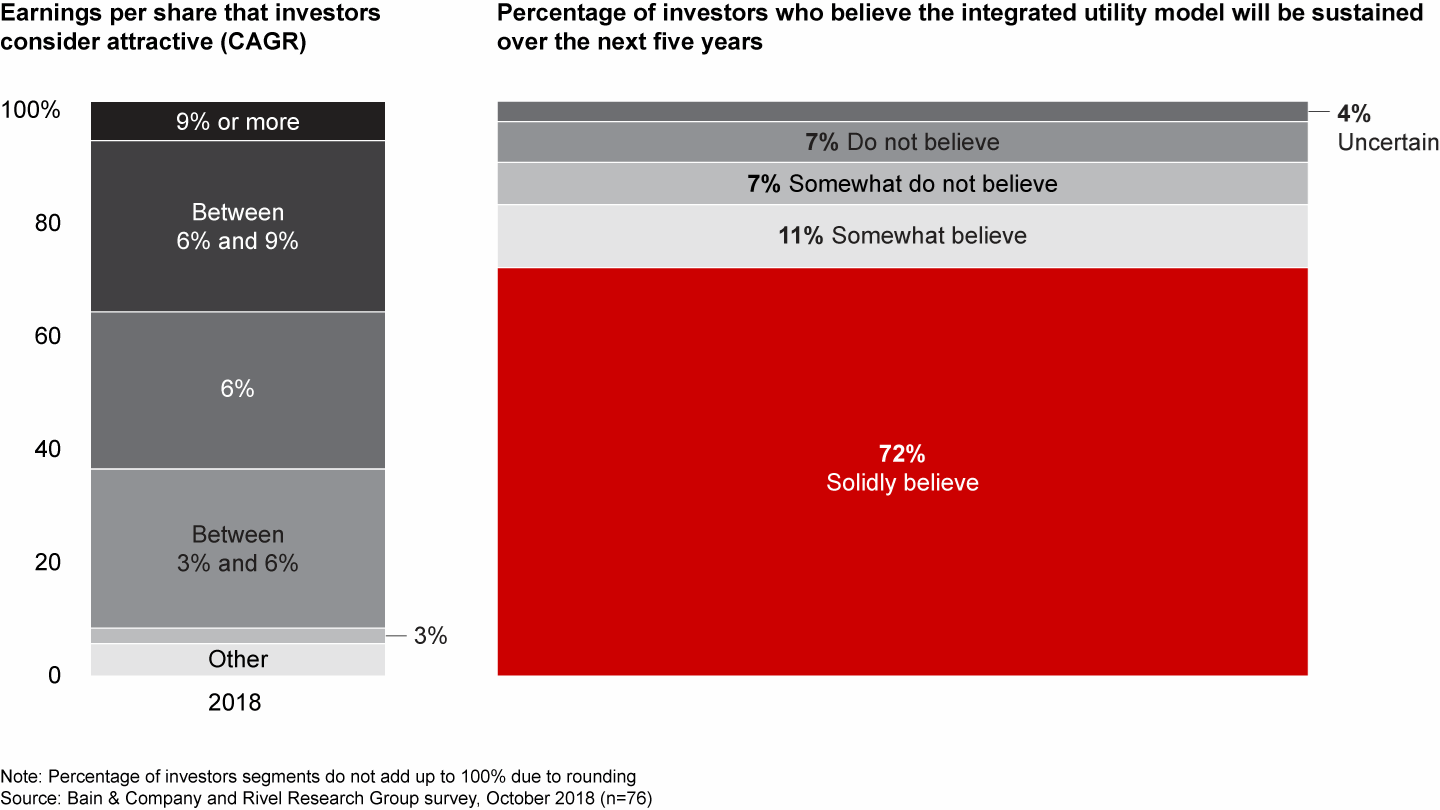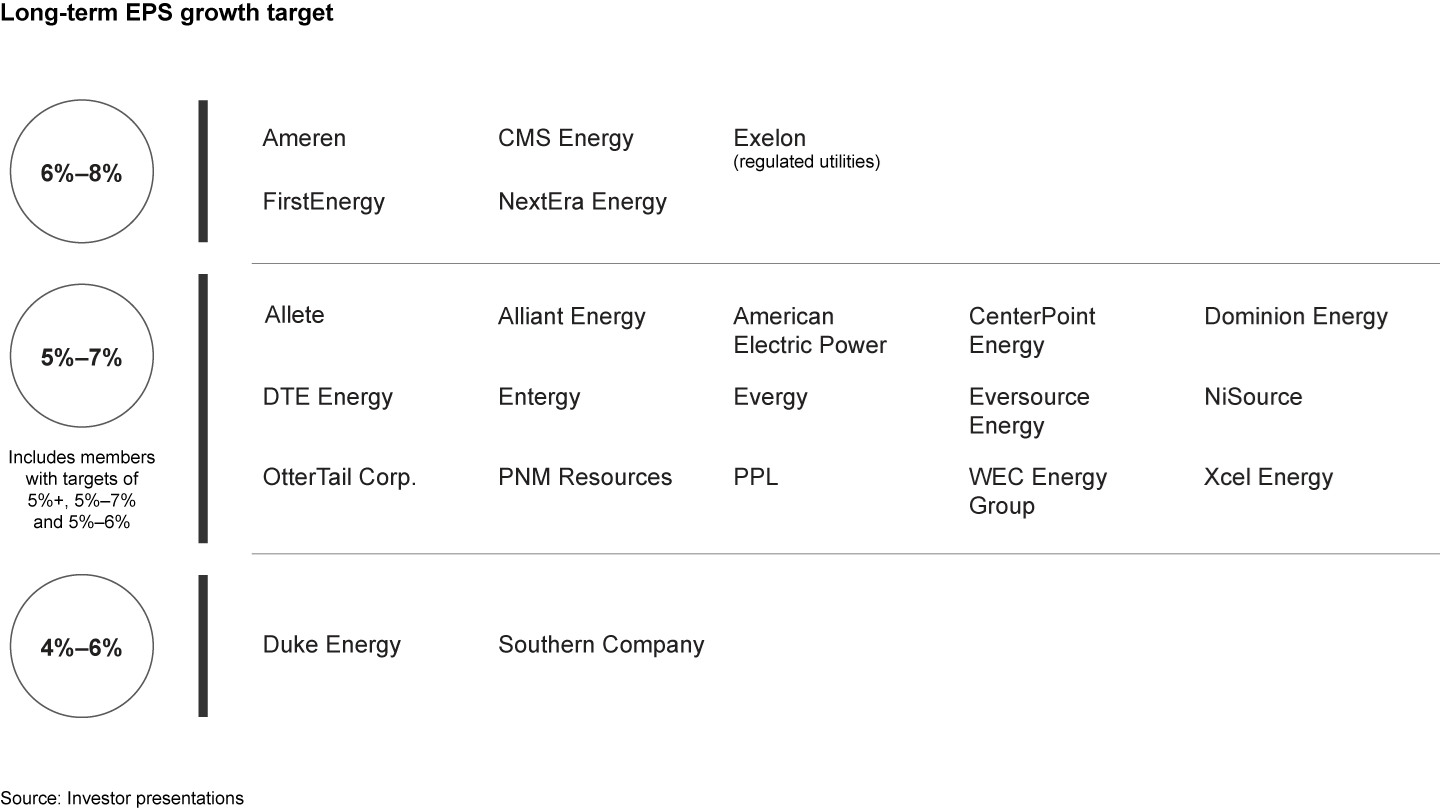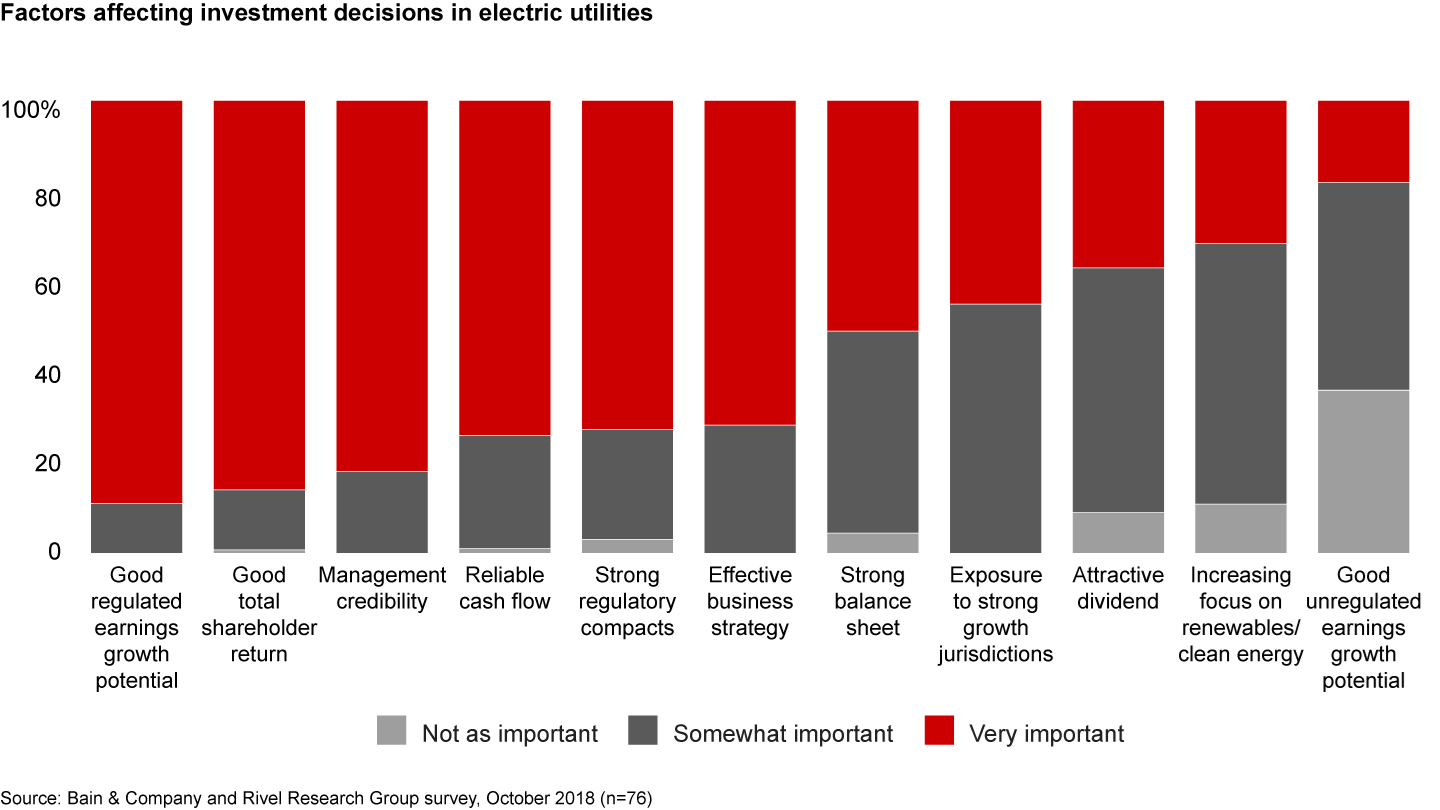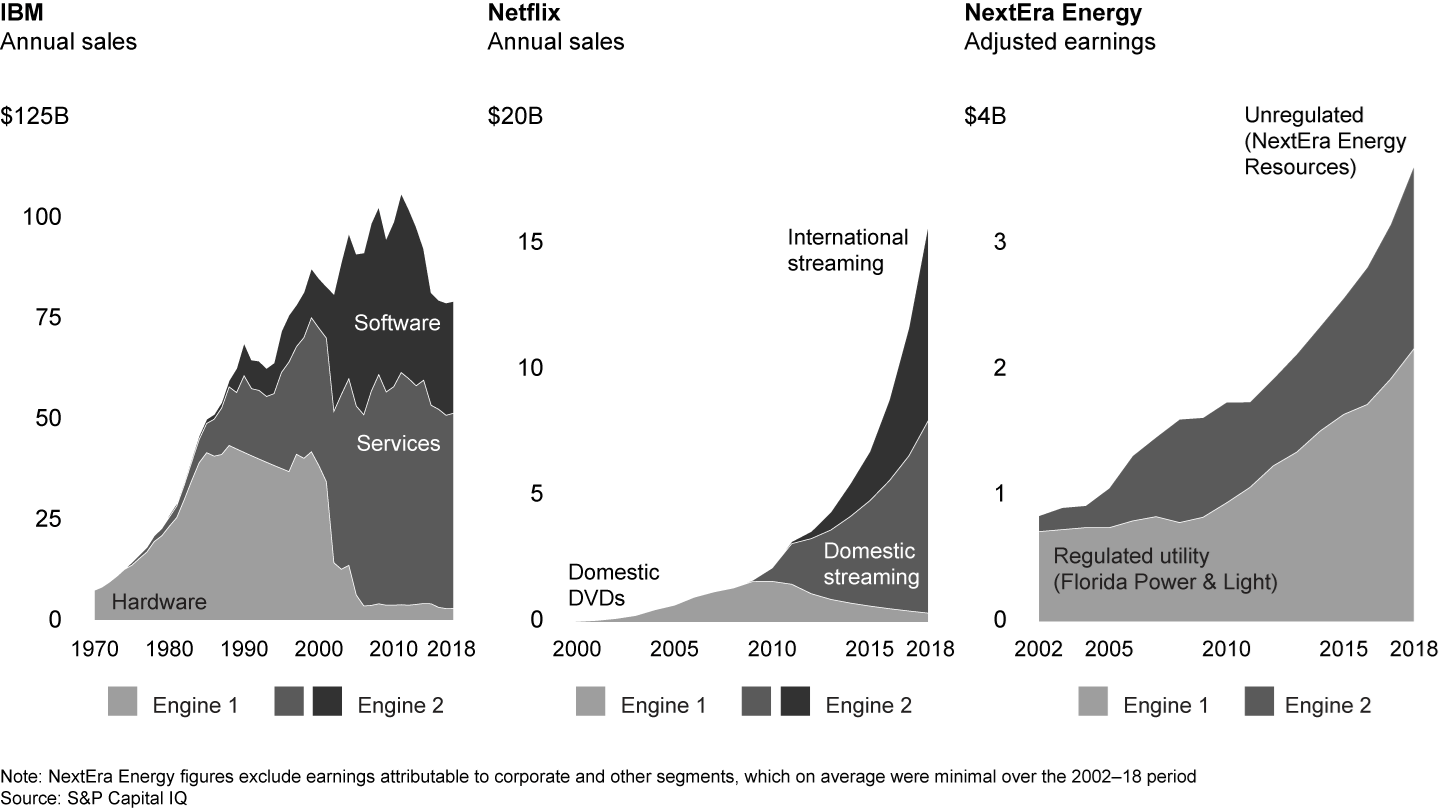Brief

In evidenza
- Investors remain confident in the regulated utility model, and most expect earnings growth of at least 6% annually—a daunting challenge given that electricity load growth is nearly flat for many utilities.
- In the core regulated utility business, every function has a role to play in supporting growth at a time of increasing competitive pressure and heightened scrutiny from regulators and stakeholders.
- Winners will use M&A to access new capital investment opportunities, build scale and realize cost savings.
- Some executive teams will develop second engines of growth outside of the regulated utility, in adjacencies that make use of their engineering and infrastructure expertise. Several utilities are exploring investments in new energy technologies, though success is far from guaranteed.
Investors expect utilities to grow the size of their businesses by 70% over the next decade in the face of flat electric load growth. That is the stark message from new research by Bain & Company and Rivel Research Group, surveying utilities investors in North America.
Our survey confirms investors’ extraordinary faith in the traditional regulated utility model (see Figure 1). Nearly three quarters of investors have a positive outlook on the sector, and more than 80% believe that the vertically integrated utility model remains sustainable. Most investors have set the bar for earnings per share (EPS) growth at 6% annually or higher.
Most investors consider EPS growth of 6% or greater attractive, and nearly three quarters have a positive outlook on the utilities sector


Utilities have given investors reason for confidence. Of 22 Edison Electric Institute utilities offering long-term EPS guidance, all but two offer targets above 5% (see Figure 2).
Among 22 major utilities in North America, 20 offer long-term EPS growth targets of 5% or greater


In a business where capital deployment drives earnings, there are plenty of opportunities to invest where it benefits customers and contributes to growth, including grid modernization and hardening, power-generation fleet transitions (for example, fuel for steel, and gas for coal), and new energy technologies like storage and solar. Even with all of these opportunities, many utilities will struggle to deploy growth capital and to sustain current growth rates in their regulated businesses over the next decade. They face three major headwinds:
- Load growth isn’t coming back. Many executive teams hold out hope that electric vehicles and electrification will bring back load growth. A recent study by the National Renewable Energy Laboratory suggests that even in the most aggressive electrification case, loads will grow at 1.2% annually through 2030. Short of major, unprecedented shifts in public policy on climate change, many utilities will face flat or negative load growth over the next decade.
- Rate and competitive pressures are rising. Slow load growth combined with inflation and the need to boost earnings creates upward pressure on rates. Rising rates are unpalatable to regulators and incent customers to push for alternatives to utility service. A recent Bain study showed that the average utility attempting to maintain rate growth at less than inflation would need to reduce nominal operations and maintenance (O&M) costs by about 20% over the next three years to accommodate just 4% to 6% EPS growth.
- Regulatory and stakeholder scrutiny is growing. The political landscape is getting more complex, and infrastructure approval is more challenging than ever. Traditional “engineering first,” lowest-cost planning models are under scrutiny, and disapprovals are increasingly common.
For every utility executive team, finding a formula that can sustain growth in the face of these headwinds will be a critical challenge.
Sustaining growth in the regulated utility
Regulated utility growth remains at the core of the utility investor value proposition. Investors like regulated investments and are clearly telling executives to pursue more of the same (see Figure 3). As noted above, a broad range of capital projects in power generation, transmission and distribution, and new energy technologies could find favor not only with investors, but with customers and regulators as well.
Growth in the core regulated utility business remains very important to investors


That said, actually approving and deploying the customer-benefitting capital at the scale required is far more challenging than in the past. Each part of the core utility has a role to play:
- The senior team must establish an “over the horizon” view of major investments and growth drivers beyond the three- or five-year financial plan.
- Financial planning and analysis teams must design a financial model that enables deployment of required capital while keeping rate growth palatable to stakeholders.
- Regulatory teams need to lead the charge in complex negotiations and deftly navigate “gives” and “gets” at the bargaining table.
- System planners, both integrated resource planning and distribution planning, need to bring more transparency and granularity to their work and recognize that engineering answers may not always be the right ones for the stakeholders that matter.
- Growth and customer teams need to launch new products, services and rate schedules to keep customers—particularly large commercial and industrial customers—on board with regulated generation service.
- Operations executives need to be more innovative than ever before in identifying opportunities to reduce O&M costs to make space for new capital investments; the pressure to manage cost while sustaining performance will be relentless.
-
Is your core on a growth footing? (click to expand)
Executives should ask themselves six questions as they look to sustain growth in the core utility:
- Do your strategy and financial planning and analysis teams have visibility into the growth trajectory of your regulated utility out to 2030, as well as the size of the gap between expected growth and ambitions?
- Does your regulatory function have a deep understanding of how the company must grow and of its role in delivering growth, including stakeholder coalitions that must be built?
- Can your distribution planning function justify grid modernization and hardening investments to outcomes at the feeder level? Is your field force ready to increase capital deployment by 20% or more?
- If vertically integrated, is your resource planning function actively considering and valuing transformative generation options, including materially accelerated replacement of legacy fleets (for example, steel for fuel)?
- If vertically integrated, do you have a plan to retain the large commercial and industrial customers that represent the greatest defection risk?
- Are you holding O&M costs flat, or reducing them, to support bill headroom for new investment opportunities?
Consolidating to drive growth
As growth becomes more challenging, more utilities are turning to consolidation, particularly when a home jurisdiction seems unlikely to deliver new opportunities. A decade from now, there are likely to be fewer, larger utilities in the US.
M&A has not been easy in this sector, especially since much of the value from mergers (particularly cost reductions) is returned to customers. However, the traditional integration approach, focused on IT integration and process issues, leaves value on the table. M&A can drive multiple benefits in support of growth, including cost synergies that create rate headroom for investments and access to new capital investment opportunities.
The sector’s M&A winners will have a clear strategy blessed by their boards, a list of acquisition targets, and a high-quality diligence process focused on growth drivers and building a sound integration thesis.
-
Ready to drive growth through consolidation? (click to expand)
Not every utility will pursue consolidation as a growth strategy, but every utility should answer the following four questions:
- Have you discussed M&A strategy with your board? In a consolidating industry, are you clear on whether you will consolidate or be consolidated?
- Do you have a view of your company’s differentiated capabilities and how that might influence the types of deal opportunities you pursue?
- Do you have a live and active market map of potential targets for acquisition, with a value-creation thesis for the most attractive targets (sources of growth, cost opportunities)?
- Do you have a world-class diligence and integration process that validates value and ensures its delivery?
Leading the transition and building a new core
Utility customers—particularly commercial and industrial customers—are increasingly demanding services beyond simple kilowatts, seeking energy that is more green and reliable. Across the sector, sources of disruption—whether deregulation, decentralization or decarbonization—are growing. In other industries, leading incumbents have shifted their businesses to adapt to customer- or technology-driven change and thrived. Take IBM’s decision to abandon hardware and sell software instead, or Netflix’s transition from renting DVDs to streaming online (see Figure 4). These moves weren’t about tinkering around the edges with products and services; they were about engineering fundamental changes to the mix of the business over time.
Across industries, building a new growth engine beyond the core can be rewarding, but it takes time


The utilities sector offers several good examples of companies that have pushed the bounds and business definition of the plain-vanilla utility. Dominion Energy, Sempra Energy and NextEra Energy have all explored growth opportunities beyond the core in adjacent infrastructure businesses, including midstream natural gas, liquid natural gas terminals and unregulated renewables. NextEra’s well-timed expansion into utility scale renewables became a second engine of growth in an unregulated business, growing at a brisk 17% rate from 2002 to 2018. In 2002, NextEra’s regulated Florida Power & Light business accounted for about 85% of the company’s net income. By 2018, the mix had shifted significantly toward the unregulated business, with NextEra Energy Resources accounting for more than 40% of net income. Our research finds that more than 37% of investors cite NextEra as the most attractive utility to invest in—an affirmation of their interest in businesses beyond the core, so long as those adjacencies are successful.
As change accelerates in the industry, the relative risk level of the core utility and adjacencies is shifting. A growing number of utility executives we speak to worry that fossil generation assets will be forced to strand years ahead of the end of useful life. In a world of heightened competition, many ask what is more risky: deploying capital into a competitive business with a quickly growing end market and clear customer demand, or into a coal unit that might close years ahead of schedule, with millions in book value remaining? Executive teams may find that the answer to that question today differs from the answer five years ago.
For utilities that decide to go beyond the core, success will require getting three things right:
- Continue to deliver growth in the regulated utility. Outstanding growth within the regulated utility is the prerequisite to investors valuing growth outside of it. NextEra, for example, sustained EPS growth of more than 7% from 2015 to 2018 inside of Florida Power & Light, its primary utility, and used some of that cash to fund new growth opportunities. Investors will not tolerate investments outside the core at a time when the regulated utility is not delivering against expectations.
- Leverage the core. Many of the failures of unregulated efforts in the 1990s and 2000s came from utility investments in businesses far from the core, such as international generation, golf courses, real estate and other unrelated investments. The best growth strategies leverage something in the core, either customer relationships or distinct capabilities.
- Don’t run the new growth engine like a utility. Leaders of new growth engines need to be distinct from regulated utility leaders, ideally coming from a commercial and unregulated background. These leaders must be given the autonomy to manage their businesses against financial targets and allowed to operate with an approval threshold that lets them act at the pace of their competitors.
-
Are you ready to build a new core? (click to expand)
Deciding and executing on an outside-the-core growth strategy are among the most difficult tasks facing utility executives today. Four questions can get you started:
- Has your executive team discussed the relative level of risk between the core utility and potential adjacent businesses?
- Do you have a clear view of the capabilities and customer relationships that could be the core of a successful adjacency?
- Does your executive team have a vision for how you will benefit from long-term shifts in sector profit pools away from the regulated utility?
- Is your outside-the-core growth engine empowered, with its own talent, governance process and P&L? Do you have total confidence in the leader of the unregulated business?
At a time of both opportunity and challenge for the utilities sector, leading executive teams are developing and executing long-term growth plans. The questions to ask are clear, as are the key ingredients: core utility growth, consolidation and growth beyond the core. Delivering against that growth plan will be the defining challenge of the decade to come.
Grant Dougans is a partner in Bain’s Utilities practice, and Joe Scalise leads the practice globally. Joe also leads the firm’s Energy & Natural Resources practice in the Americas.